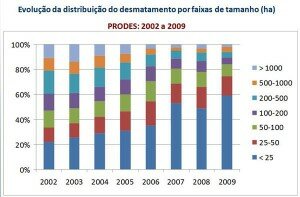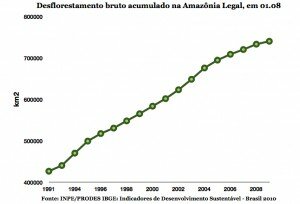Deforestation in the Brazilian Amazon: positive trends, changing patterns
Sergio Abranches
Logging of large areas in the Amazon region has dropped significantly, from August 2009 to July 2010. Both the Brazilian Space Agency, INPE, and Imazon, a non-governmental think-act tank, have captured this trend on their monitoring through satellite images. Imazon says that this trend holds for both large and medium sized plots with at least 12,5 ha. INPE’s head, Gilberto Camara, alerts that the satellite used, MODIS, can’t see logging in areas smaller than 100 ha.
Gilberto Câmara said that logging is increasing in areas of 25 ha or smaller. He explained on his Twitter that INPE’s system, DETER, captures trends, but cannot detect small logging. He also informed that 80% of current illegal logging activity have less than 100 ha. See below the chart he posted.
Adalberto Veríssimo, senior researcher at Imazon tweeted that, by Amazon standards, logging of areas of 12.5 ha should be considered as medium sized.
There is significant consensus among experts about what is happening, in spite of these diverging views on metrics. First, logging of large areas is plummeting. Second, the pattern of logging is changing: logging is increasing at small and medium sized plots, while large logging is decreasing. Third, deforestation is growing in the Southern part of the Amazonas state, an area where forest protection used to be more effective.
Beto Veríssimo has told me that Imazon has detected logging in areas where the forest is denser. This means that the loss of carbon and quality of forest mass by logged hectare is larger than before. Veríssimo argues that logging in the Amazon has a new pattern besides the shift of scale. The main vectors of this new pattern are the Transamazonica and BR-163 roads, agrarian reform settlements, extensive cattle raising, and land grabbing.
Gilberto Câmara is a bit more cautious and says it is too early to talk about a new pattern, solely on the basis of data generated by the SAD (Imazon) and DETER (INPE) models. He would prefer to say this is a trend already detected by the PRODES model in 2009, INPE’s measurement system based on high-resolution satellite images.
Câmara’s cautiousness is welcome. Brazil is on the last month of electoral campaign, and deforestation data have been presented with a political twist by the ministers of Environment and Science and Technology. Câmara wants to make it clear that these are preliminary data without the necessary reach and precision to support definitive conclusions about deforestation patterns.
Although lacking accuracy these observations show that there are forces in action effective enough to change the dynamics, scale and territorial distribution of logging. Câmara is right, though, to say that only the data generated by the high res PRODES model will provide accurate confirmation of these trends.
The soy moratorium and the refusal of large supermarket chains to buy meat from meatpackers operating in deforestation areas have certainly contributed to the reduction of the scale of logging. These two agreements have neutralized the main traditional vectors of deforestation: soybean plantation and cattle ranching. It is important to notice that both resulted from pressure over large consumers by the social movement, without any supporting government policy. Greenpeace, on both counts, produced information and exerted strong pressure to persuade McDonald’s, in the case of soybean exports, and the major supermarket chains – Walmart, Carrefour and Pão de Açúcar – in the case of beef. The government entered as a partner to the agreements after the deals were closed.
But it is also true that policies against deforestation and repression of logging have also contributed to this change. Beto Veríssimo, who is often consulted by policy-makers and systematically evaluates policies for the Amazon region says that measures against logging, especially those adopted during Marina Silva’s term as Environment Minister, have contributed very much to falling deforestation rates.
Imazon’s report has analyzed the situation of 41 towns listed in the government anti-logging policy as those with the larger areas and rates of deforestation, deserving particular attention from authorities. It shows that there was an average 40% reduction of logging in these “critical towns”.
They were divided into three different groups: the first comprising the towns where logging has decreased; the second encompassing towns where there has still been from low to moderate logging; the third, grouping those where logging has increased. The first group has 24 towns, 57% of the list. Deforestation has decreased on average 64% in this group. Group 2 has 8 towns, 19%, their average deforestation rate was 14%. In Group 3, with 24% of the towns on the list, deforestation has increased by 157% on average.
Falling logging rates are good news, but they do not mean the Amazon is not losing forest cover. On the contrary, the loss of forest cover is still too large for anyone to be comfortable with anti-deforestation policies. The chart below shows that the accumulated deforested area continues to grow.
I share Beto Veríssimo’s view that it is about time the Brazilian government sets zero deforestation as a target, instead of the goal of 80% reduction of logging rates by 2020. Veríssimo thinks that zero deforestation by 2014 would be perfectly feasible.
Tags: Amazon, Climate Change, deforestation, sustainability




